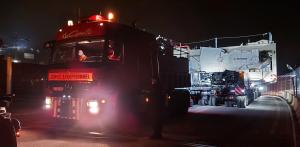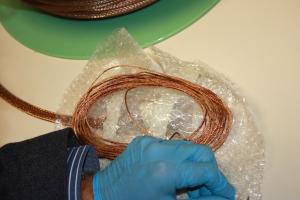A stowaway on board toroidal field coil #8
Hidden inside the steel case of the most recent toroidal field coil delivered to ITER—TF8, from Japan—is a unique and critical diagnostic device. Named after the German physicist Walter Rogowski, the continuous external Rogowski (CER) coil is one of ITER's primary diagnostic instruments for measuring plasma current.
From its location inside of the toroidal field coil case, tucked safely into guiding grooves and "frozen" in place by resin, the role of each CER coil is to measure the toroidal current flowing inside the ITER plasma, a key diagnostic measurement with implications for operation safety and plasma control.
The detector of a CER coil is a rope-like structure, formed by two layers of concentric helical windings insulated by fibreglass and enclosed in a copper-nickel braided sheath. It works with just one or two extended sensors, resulting in high reliability despite serving in harsh conditions with cryogenic temperatures, high vacuum and mechanical stresses inside the toroidal field coils.
Five units of CER coils procured by the European Domestic Agency were delivered to the ITER site in 2015; of these, three will be integrated into toroidal field coils (TF8, TF2 and TF14), while two will serve as spares. The components underwent a full range of qualification tests confirming vacuum leak tightness and pressure rating at the nearby CEA/ITER Magnet Infrastructure Facilities (MIFI), before they were relayed to toroidal field coil manufacturing facilities in Japan, Korea and Europe for integration.
For toroidal field coil #8, the integration of the CER coil was carried out over 18 months, from January 2019 to August 2020, and concluding with factory acceptance tests. Integrating a CER coil requires multiple steps. First, the rope-like CER detector cable is inserted into the guiding grooves inside the inboard and outboard sections of the toroidal field coil cases. Then, the ends of the CER cable are joined outside of the toroidal field coil structure and wired with an electrical feedthrough. Finally, the interspace between the diagnostic and the toroidal field coil structure is fully filled with resin to cast the CER cable into the guiding grooves and conduits. The entire workflow was executed under the close joint supervision of the Japanese Domestic Agency and representatives of the ITER magnet and diagnostics teams.
The second set of CER coils has been fully integrated to toroidal field coil #2 (TF2) in Japan, and will be shipped to the ITER site after the manufacturing scope of this coil is completed. For TF14, the CER detector cables were already placed inside the toroidal field coil case manufactured in Japan; further cable connection, wiring, and resin filling will take place at SIMIC, the toroidal field coil integration facility in Europe.



